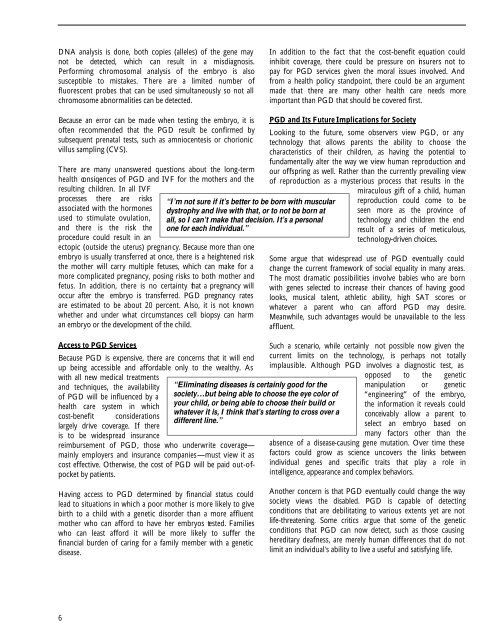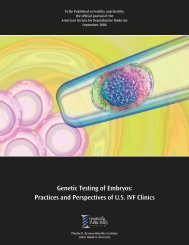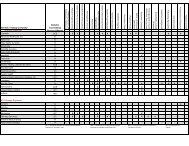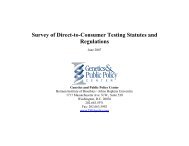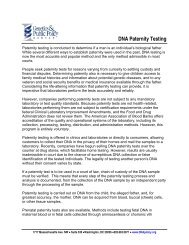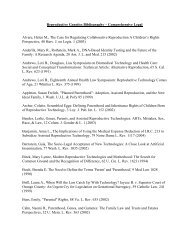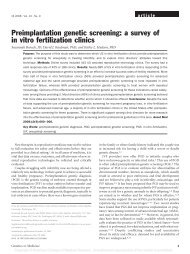Preimplantation Genetic Diagnosis - Genetics & Public Policy Center
Preimplantation Genetic Diagnosis - Genetics & Public Policy Center
Preimplantation Genetic Diagnosis - Genetics & Public Policy Center
Create successful ePaper yourself
Turn your PDF publications into a flip-book with our unique Google optimized e-Paper software.
DNA analysis is done, both copies (alleles) of the gene may<br />
not be detected, which can result in a misdiagnosis.<br />
Performing chromosomal analysis of the embryo is also<br />
susceptible to mistakes. There are a limited number of<br />
fluorescent probes that can be used simultaneously so not all<br />
chromosome abnormalities can be detected.<br />
In addition to the fact that the cost-benefit equation could<br />
inhibit coverage, there could be pressure on insurers not to<br />
pay for PGD services given the moral issues involved. And<br />
from a health policy standpoint, there could be an argument<br />
made that there are many other health care needs more<br />
important than PGD that should be covered first.<br />
Because an error can be made when testing the embryo, it is<br />
often recommended that the PGD result be confirmed by<br />
subsequent prenatal tests, such as amniocentesis or chorionic<br />
villus sampling (CVS).<br />
There are many unanswered questions about the long-term<br />
health consiqences of PGD and IVF for the mothers and the<br />
resulting children. In all IVF<br />
processes there are risks<br />
associated with the hormones<br />
used to stimulate ovulation,<br />
and there is the risk the<br />
procedure could result in an<br />
“I’m not sure if it’s better to be born with muscular<br />
dystrophy and live with that, or to not be born at<br />
all, so I can’t make that decision. It’s a personal<br />
one for each individual.”<br />
ectopic (outside the uterus) pregnancy. Because more than one<br />
embryo is usually transferred at once, there is a heightened risk<br />
the mother will carry multiple fetuses, which can make for a<br />
more complicated pregnancy, posing risks to both mother and<br />
fetus. In addition, there is no certainty that a pregnancy will<br />
occur after the embryo is transferred. PGD pregnancy rates<br />
are estimated to be about 20 percent. Also, it is not known<br />
whether and under what circumstances cell biopsy can harm<br />
an embryo or the development of the child.<br />
Access to PGD Services<br />
Because PGD is expensive, there are concerns that it will end<br />
up being accessible and affordable only to the wealthy. As<br />
with all new medical treatments<br />
and techniques, the availability<br />
of PGD will be influenced by a<br />
health care system in which<br />
“Eliminating diseases is certainly good for the<br />
society…but being able to choose the eye color of<br />
your child, or being able to choose their build or<br />
whatever it is, I think that’s starting to cross over a<br />
different line.”<br />
cost-benefit considerations<br />
largely drive coverage. If there<br />
is to be widespread insurance<br />
reimbursement of PGD, those who underwrite coverage—<br />
mainly employers and insurance companies—must view it as<br />
cost effective. Otherwise, the cost of PGD will be paid out-ofpocket<br />
by patients.<br />
PGD and Its Future Implications for Society<br />
Looking to the future, some observers view PGD, or any<br />
technology that allows parents the ability to choose the<br />
characteristics of their children, as having the potential to<br />
fundamentally alter the way we view human reproduction and<br />
our offspring as well. Rather than the currently prevailing view<br />
of reproduction as a mysterious process that results in the<br />
miraculous gift of a child, human<br />
reproduction could come to be<br />
seen more as the province of<br />
technology and children the end<br />
result of a series of meticulous,<br />
technology-driven choices.<br />
Some argue that widespread use of PGD eventually could<br />
change the current framework of social equality in many areas.<br />
The most dramatic possibilities involve babies who are born<br />
with genes selected to increase their chances of having good<br />
looks, musical talent, athletic ability, high SAT scores or<br />
whatever a parent who can afford PGD may desire.<br />
Meanwhile, such advantages would be unavailable to the less<br />
affluent.<br />
Such a scenario, while certainly not possible now given the<br />
current limits on the technology, is perhaps not totally<br />
implausible. Although PGD involves a diagnostic test, as<br />
opposed to the genetic<br />
manipulation or genetic<br />
“engineering” of the embryo,<br />
the information it reveals could<br />
conceivably allow a parent to<br />
select an embryo based on<br />
many factors other than the<br />
absence of a disease-causing gene mutation. Over time these<br />
factors could grow as science uncovers the links between<br />
individual genes and specific traits that play a role in<br />
intelligence, appearance and complex behaviors.<br />
Having access to PGD determined by financial status could<br />
lead to situations in which a poor mother is more likely to give<br />
birth to a child with a genetic disorder than a more affluent<br />
mother who can afford to have her embryos tested. Families<br />
who can least afford it will be more likely to suffer the<br />
financial burden of caring for a family member with a genetic<br />
disease.<br />
Another concern is that PGD eventually could change the way<br />
society views the disabled. PGD is capable of detecting<br />
conditions that are debilitating to various extents yet are not<br />
life-threatening. Some critics argue that some of the genetic<br />
conditions that PGD can now detect, such as those causing<br />
hereditary deafness, are merely human differences that do not<br />
limit an individual's ability to live a useful and satisfying life.<br />
6


